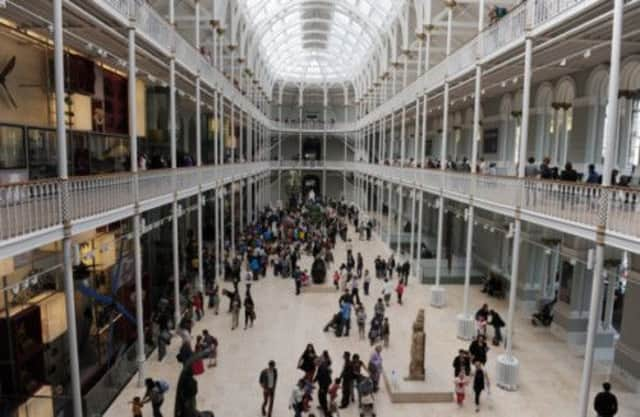Calls to repair sign underneath ‘oldest Saltire’


The iconic Saltire, believed to have been flown at the Battle of Dunbar in 1650, is housed in the museum’s Hawthorden Court and reached by a small corridor depicting stirring extracts from the 1320 Declaration of Arbroath.
However the word “Scotland” has been almost obliterated from the sign under the blue silk Saltire. The defaced sentence reads “The saltire became a symbol of S----as a united and independent nation.” The sign has been left in this condition since at least April.
Advertisement
Hide AdJoan McAlpine, SNP MSP for South Scotland, said she was “greatly disappointed” at the condition of such an exhibit at one of Scotland’s top visitor attractions and said she would be writing to Dr Gordon Rintoul, the museum’s director, to ask for an explantion and demand
its repair ahead of St Andrew’s Day later this month.
“We don’t know if this is pointless vandalism or political extremism but whatever the reason for defacing it I’m surprised and greatly disappointed,” said Ms McAlpine.
“I will be writing to the director of the museum to ask that it is repaired in time for St Andrew’s Day on 30 November. It’s surprising that this situation has been allowed to continue particularly since the museum’s refurbishment and it is such a fantastic visitor attraction for Scotland and visitors from overseas.”
Saltire 2013 Festival
The call comes ahead of The Saltire 2013 festival in East Lothian later this month, the birthplace of the Scottish flag. The festival is part-funded by Event Scotland as part of its St Andrew’s Day programme and is part of the Scotland’s Winter Festivals programme.
Iain Gray, Labour MSP for East Lothian, also called for the sign to be restored ahead of the Saltire celebrations.
“The saltire is an important symbol of Scotland for all Scots, whatever their views on independence.
Advertisement
Hide Ad“We are especially proud of it here in East Lothian, home of the Saltire, and of course the example in the National Museum comes from the Battle of Dunbar, also in East Lothian. The Museum really should ensure that the damage done to the exhibit is repaired as soon as possible.”
The museum was the most-visited free attraction outside of London last year and saw a 29.11 per cent increase in visitors to more than 1.89 million.
It re-opened in July 2011 after a £47m restoration project.
Advertisement
Hide AdA spokeswoman for National Museums Scotland said she did not believe the sign had been vandalised but said the lettering on the word “Scotland” had worn out due to “wear and tear” “We can confirm that there has been no vandalism of the label which accompanies the Saltire flag in Kingdom of the Scots.
“The text on the labels in this gallery is screen printed and due to general wear and tear resulting from the very large number of visitors we receive, there is a need to periodically replace some of the labels. This particular label, together with some others, is due to be replaced in the near future.”
‘Surprise’
Maurice Davies, head of policy at the Museums Association, said he was surprised the sign had been left in such a condition for so long but said many museum budgets were over-stretched.
“It’s obviously unfortunate if something which has been damaged or defaced has not been corrected more speedily.
“But perhaps this is a reflection of the pressure the museum is under attracting more visitors on a reduced budget.
“I would hope that in general museums should be in a postion to keep their exhibits in tip-top condition but this is largely dependent on government money not being cut.”
Advertisement
Hide AdAthelstanefored in East Lothian is regarded as the birthplace of Scotland’s national flag.
The traditional story surrounding the flag, the oldest in Europe and the Commonwealth, is that it originated in a battle fought near to the vaillage of Athelstaneford in 832AD.
Advertisement
Hide AdAn army of PIcts led by King Aengus, aided by a contingent of Scots,
was invading Lothians - which was Northumbrian territory - when it was suddenly surrounded by a much larger army of Saxons led by Athelstan.
Aengus prayed for deliverance and is said to have seen a cloud formation of a white saltire against the blue sky. He vowed that if victorious Andrew would be made patron saint of Scotland.